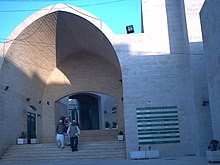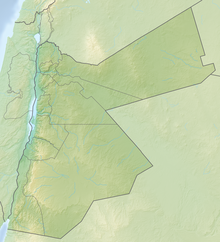
Back غزوة مؤتة Arabic غزوة مؤته ARZ Mütə döyüşü Azerbaijani سریه مؤته دؤیوشو AZB মুতার যুদ্ধ Bengali/Bangla Batalla de Muta Catalan شەڕی موئتە CKB Batalla de Mu'tah Spanish نبرد موته Persian Bataille de Mu'tah French
| Battle of Mu'tah غَزْوَة مُؤْتَة مَعْرَكَة مُؤْتَة | |||||||
|---|---|---|---|---|---|---|---|
| Part of the Arab–Byzantine wars | |||||||
 The tomb of Muslim commanders Zayd ibn Haritha, Ja'far ibn Abi Talib, and Abd Allah ibn Rawahah in Al-Mazar near Mu'tah, Jordan | |||||||
| |||||||
| Belligerents | |||||||
| Muslim Arabs |
Byzantine Empire Ghassanids | ||||||
| Commanders and leaders | |||||||
|
Zayd ibn Haritha † Ja'far ibn Abi Talib † Abd Allah ibn Rawaha † Khalid ibn al-Walid |
Theodore Mālik ibn Zāfila † | ||||||
| Strength | |||||||
| 3,000[5] |
100,000 (Al-Waqidi)[6] | ||||||
| Casualties and losses | |||||||
| 12[11] (Disputed)[12][13] | Unknown | ||||||
Location within Jordan | |||||||
The Battle of Mu'tah (Arabic: مَعْرَكَة مُؤْتَة, romanized: Maʿrakat Muʿtah, or Arabic: غَزْوَة مُؤْتَة Ghazwat Muʿtah) took place in September 629 (1 Jumada al-Awwal 8 AH),[1] between the forces of Muhammad and the army of the Byzantine Empire and their Ghassanid vassals. It took place in the village of Mu'tah in Palaestina Salutaris at the east of the Jordan River and modern-day Karak.
In Islamic historical sources, the battle is usually described as the Muslims' attempt to take retribution against a Ghassanid chief for taking the life of an emissary. According to Byzantine sources, the Muslims planned to launch their attack on a feast day. The local Byzantine Vicarius learned of their plans and collected the garrisons of the fortresses. Seeing the great number of the enemy forces, the Muslims withdrew to the south where the fighting started at the village of Mu'tah and they were either routed or retired without exacting a penalty on the Ghassanid chief.[14][4][2] According to Muslim sources, after three of their leaders were killed, the command was given to Khalid ibn al-Walid and he succeeded in saving the rest of the force.[4]
Three years later the Muslims would return to defeat the Byzantine forces in the Expedition of Usama bin Zayd.
- ^ a b Kaegi 1992, p. 72.
- ^ a b Kaegi 1992, p. 67.
- ^ Donner 1981, p. 105.
- ^ a b c d Buhl 1993, p. 756-757.
- ^ Powers 2009, p. 86.
- ^ Gil, Moshe (1997-02-27). A History of Palestine, 634-1099. Cambridge University Press. p. 23. ISBN 978-0-521-59984-9.
- ^ Ibn Ishaq (2004). The Life of Muhammad. A. Guillaume (trans.). Oxford University Press, USA. pp. 532, 536. ISBN 0-19-636033-1.
They went on their way as far as Ma'ān in Syria where they heard that Heraclius had come down to Ma'āb in the Balqāʾ with 100,000 Greeks joined by 100,000 men from Lakhm and Judhām and al-Qayn and Bahrāʾ and Balī commanded by a man of Balī of Irāsha called Mālik b. Zāfila. (p. 232) Quṭba b. Qatāda al-'Udhrī who was over the right wing had attacked Mālik b. Zāfila (Ṭ. leader of the mixed Arabs) and killed him, (p. 236)
- ^ Haldon 2010, p. 188.
- ^ Peters 1994, p. 231.
- ^ Kaegi 1992, p. 79.
- ^ Powers, David S. (2014-05-23). Zayd. University of Pennsylvania Press. pp. 58–9. ISBN 978-0-8122-4617-9.
- ^ Peterson 2007, p. 142.
- ^ Powers 2009, p. 80.
- ^ W, Montgomery Watt (1956). Muhammad at Medina. Oxford University Press. pp. 54–55, 342. ISBN 978-0-353-30668-4.
